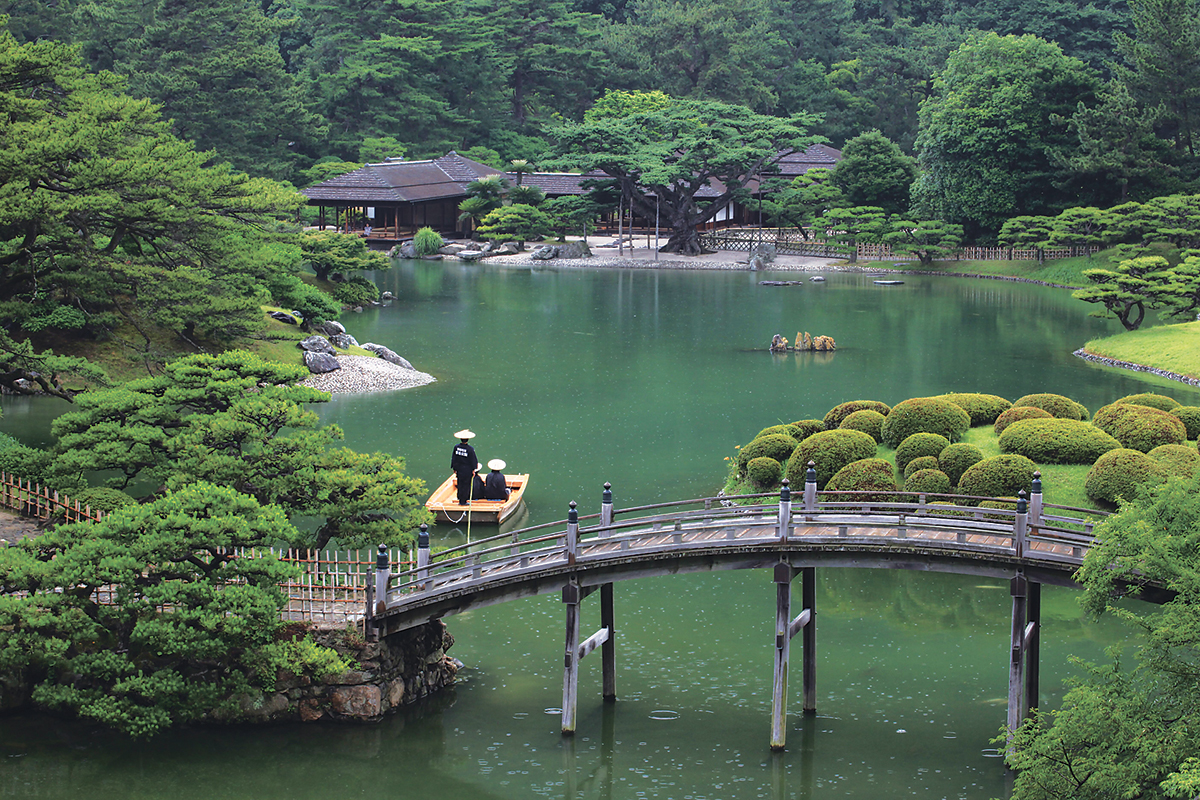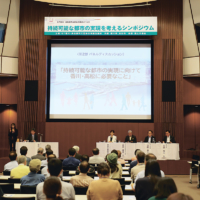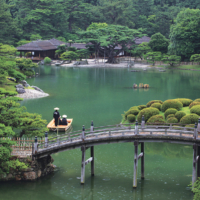The city of Takamatsu in Kagawa Prefecture will be the first Japanese city to host a G7 Sustainable Urban Development Ministers’ Meeting. The meeting, which will be the second following the first held in Potsdam, Germany, last year, will take place at Kagawa International Conference Hall from July 7 to 9, with particular focus on zero carbon emissions, resilience, inclusiveness and digital technologies.
Prior to the ministerial meeting, a symposium to discuss topics related to the creation of sustainable cities was held at the conference hall on May 21. Mamoru Taniguchi, a professor from Tsukuba University’s Graduate School of Science and Technology and an expert on urban policies, gave a lecture on how modern cities can improve their sustainability.

He compared the condition of typical modern cities to a patient suffering from lifestyle diseases that worsened over the years and stressed that general improvement in health is necessary to address various issues that communities have in line with the promotion of sustainability on a global scale. Referring to public transportation as one of the areas that cities can improve, he said, “It is said that when the population is halved, carbon emissions double in Japan’s rural areas,” which results from a vicious cycle of a decreasing population leading to deteriorating public transportation management, and accelerating depopulation due to the resulting inconvenience.
He pointed out the importance of considering public transportation as a “tool to achieve a surplus as an entire town” instead of being concerned about the profitability of the public transportation system itself.
In a panel discussion moderated by Taniguchi, Kagawa Gov. Toyohito Ikeda, Takamatsu Mayor Hideto Onishi, Takamatsu Marugamemachi Shotengai (shopping street) Promotion Association Chairperson Kozo Furukawa and freelance television announcer Minako Nakano discussed issues affecting Takamatsu and its surrounding municipalities, and exchanged ideas about how to solve them.
Positioning decarbonization at the core of urban development, Ikeda introduced some of the decarbonization efforts made by the prefecture. He pointed out that the home ownership rate in Kagawa is higher than most other prefectures in Japan, and that Kagawa has two major ports and is home to many industries that emit a lot of carbon dioxide. The prefectural government financially supports the implementation of solar power generation systems, high-efficiency insulation and other energy saving functions in homes, and is working on a plan to make the ports carbon-neutral. “To decarbonize the entire city, we also need to develop the city in a way that avoids excessive dependence on cars,” he said, explaining that the plan to turn the Sunport Takamatsu area, where the conference hall is located, as well as other districts in central Takamatsu into pedestrian-friendly promenades is underway.
Onishi suggested that digitalization of infrastructural information is also an important factor in sustainable urban development. “We are creating a digital map of Takamatsu that includes information on the city’s roads,” he said and explained that in the future many administrative procedures, such as obtaining permission to use roads and public facilities, can be done on the map. “We also hope the digital map will provide the basis for various new services designed under public-private partnerships.”
Takamatsu is one of the model cities using Plateau, a growing digital transformation platform for urban development led by the Ministry of Land, Infrastructure, Transport and Tourism. Within the framework of Plateau, a project to compile data and visualize urban structure is underway. He also touched on a design contest for children to be held from July to encourage the younger generation to use various sets of city data to think about and design a future city in Minecraft, an online sandbox game.
Furukawa explained the history of Marugamemachi, a downtown area of Takamatsu, and said that inflated land prices caused by the bubble economy of the late 1980s made it impossible for people to live in the city center. This led to the decline of the main shopping street in the area that further accelerated depopulation. “To ensure a tenant mix that offers convenience for residents and revive the city, we created an area management system in which a company owned by residents rents the entire area on a 60-year lease to build and manage buildings,” he said.
Nakano, who was born and raised in Kagawa and lived in Singapore from 2012 to 2018, shared some advanced examples of smart city efforts that Singapore has been making, such as smartphone applications that facilitate convenient commuting and traveling, online medical examinations and electronic prescriptions. “From a resident’s perspective, there are more things that can be done to revive the area such as improving the bus network and other public transportation,” she said.
On the same day as the symposium, various related events were held in the Sunport Takamatsu area. Sanuki Marche in Sunport, a monthly market that sells local produce and delicacies, was held in an extended version with a special zone themed on the U.N.’s sustainable development goals. This market is aligned with the prefecture’s efforts to attract people and revive this area that is easily accessible by public transportation. About 70 stalls were set up by local producers, shop owners, nonprofit organizations and schools to sell or showcase local items such as olive products, as well as SDG-conscious items.
G7 Cafe Silver, a kitchen trailer, set up in an open area called Takamatsu Harbor Promenade just a few minutes from the tower, sold coffee, craft beer, lunch boxes and other snacks. Visitors sat at tables placed in between the cafe and the waters of Takamatsu Port and enjoyed the panoramic view of the sea with their food and drinks. The cafe is open daily except Mondays through the end of October.

Takamatsu Port is not the only place in Takamatsu that offers magnificent seascape scenery. Yashimaru is a uniquely shaped, artistic building that opened at the top of Mount Yashima in the eastern area of the city in August 2022. The building itself is a piece of art that was exhibited at the Setouchi Triennale 2022. Its curving corridors with glass walls and observation deck that match the landscape of Yashima offer a view of the sea dotted with small beautiful islands, as well as a view of downtown Takamatsu. The facility also showcases the nature, history and culture of Yashima.
The Yashima district is home to Mount Yashima and its mountaintop facility Yashimaru, which received this year’s Urban Landscape Grand Prize in the Urban Space Category from the Ministry of Land, Infrastructure, Transport and Tourism.
Leading to this prestigious award was a public-private partnership to bring out the potential of this area, including the stunning view from Yashimaru, as well as improvement of the routes leading to the mountaintop. The plan to revitalize the entire district included the renewal of the Reiganchaya cafe at the top of Mount Yashima and the Shikokumura Museum, an open-air space that showcases relocated traditional buildings such as houses, workshops, playhouses, rice warehouses and soy sauce factories built between the Edo and Taisho periods (1603 to 1926).
Yashima’s efforts were recognized by the award screening committee as a successful example of revitalizing a former tourism spot.
People touring Takamatsu are able to enjoy picturesque seascapes, verdant greenery and a vibrant town in a fairly small area.
Kagawa offers stunning scenery
by TOYOHITO IKEDA
KAGAWA GOVERNOR

I would like to extend a warm welcome to people from around the world who have come to Takamatsu, Kagawa Prefecture. It is a great honor for Kagawa and Takamatsu to host the first G7 Sustainable Urban Development Ministers’ Meeting held in Japan. My heartfelt welcome goes to all of you.
Kagawa and Takamatsu face the gentle Seto Inland Sea and the towns near the sea are blessed with a mild climate. The sea and the towns in our region are close to each other. Scenic views created by the many islands in the Seto Inland Sea can be admired from various angles and different locations, including the Sunport Takamatsu district at the Takamatsu Port waterfront and Mount Yashima, a small plateau in the eastern area of Takamatsu.
Naoshima and some other islands of the Seto Inland Sea are the venues of the Setouchi Triennale, an art event held once every three years. A large number of artworks are displayed on these islands, creating a fusion of nature and art that fascinates visitors.
Designated as a Special Place of Scenic Beauty by the Japanese government, Ritsurin Garden is a promenade garden built in the early Edo Period (1603 to 1867). It features six carefully arranged ponds and 13 miniature mountains, with Mount Shiun providing a deep green background. Featuring ingenious divisions of space, rock arrangements and trees, the garden is rich in its elegance. Strolling in the garden, one can feel the changing of the seasons in a fusion of history and nature.

We are looking forward to welcoming visitors from all around the world, with the utmost hospitality that you can only experience in Kagawa and Takamatsu.
It is my sincere wish that the 2023 G7 Sustainable Urban Development Ministers’ Meeting will successfully send a powerful message to help “Achieve Sustainable Urban Development Together,” the theme of the meeting, in Takamatsu.
This page is sponsored by the Kagawa Prefectural Government.








